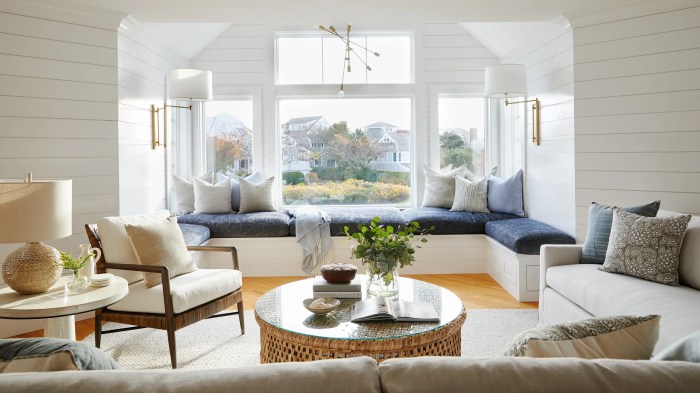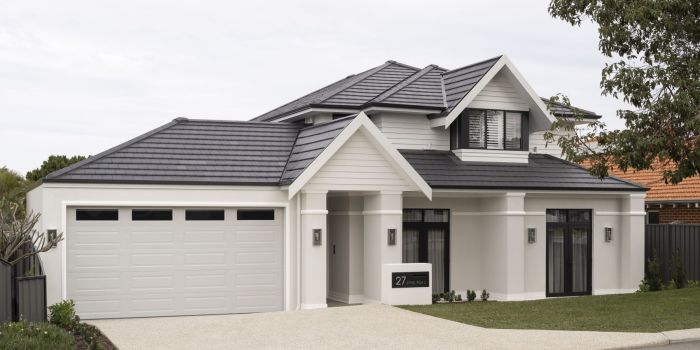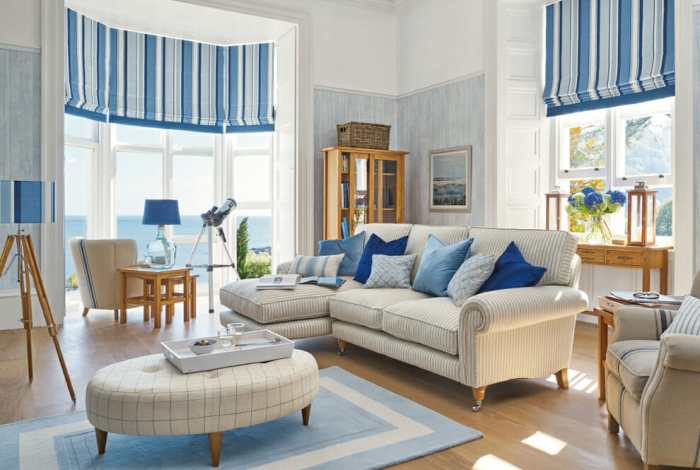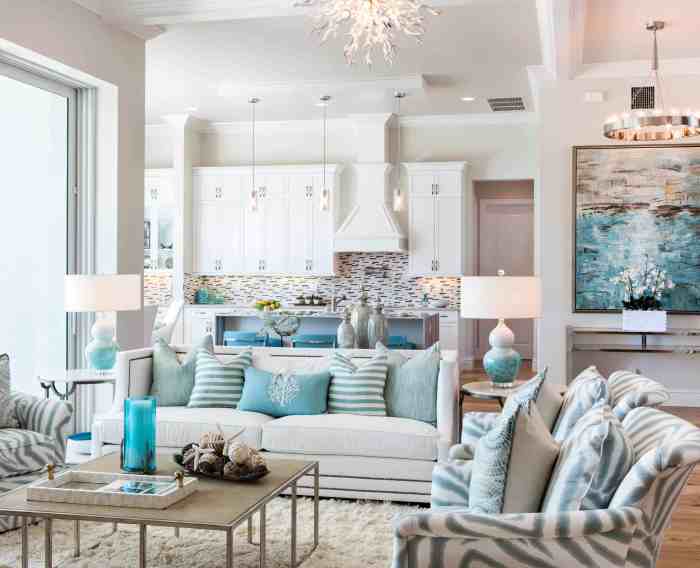Coastal home style evokes a sense of relaxed elegance, drawing inspiration from the natural beauty of seaside locales. This design aesthetic transcends mere decoration; it’s a philosophy that integrates the calming influence of the ocean and the invigorating freshness of the sea breeze into the very fabric of the home. From the sun-drenched shores of California to the rocky coastlines of New England, distinct regional variations contribute to the diverse tapestry of coastal design.
This exploration delves into the defining characteristics of this popular style, examining its color palettes, materials, furniture choices, and regional adaptations. We will uncover the scientific principles behind the use of natural light and the selection of climate-appropriate materials, revealing the interplay between design and environmental factors.
The core principles of coastal design hinge on creating a space that feels both inviting and airy, reflecting the fluidity and openness of the ocean. This is achieved through a careful selection of colors, materials, and furniture that evoke a sense of tranquility and connection with nature. The use of natural light is paramount, creating a bright and cheerful atmosphere that mirrors the sunlit beaches and sparkling waters that inspire this style.
Furthermore, understanding how different climates influence design choices, from hurricane-resistant construction in the Caribbean to the use of insulating materials in the Pacific Northwest, adds a layer of complexity to this seemingly simple aesthetic. We’ll analyze these aspects to fully appreciate the multifaceted nature of coastal home design.
Defining Coastal Home Style

Coastal home style evokes a sense of relaxed elegance, drawing inspiration from the natural beauty of the ocean and the surrounding environment. This aesthetic transcends mere decoration; it’s a design philosophy that emphasizes natural light, breezy spaces, and a connection to the outdoors, reflecting the calming influence of the sea. The core characteristics are designed to create a sense of tranquility and effortless sophistication.
The defining features include a light and airy color palette, often incorporating blues, greens, whites, and sandy beiges. Natural materials such as wood, wicker, and linen are prevalent, contributing to a sense of warmth and casual sophistication. Open floor plans and large windows maximize natural light and provide expansive views, blurring the lines between indoor and outdoor living.
Architectural details may include shiplap siding, exposed beams, and nautical accents.
Coastal Home Style Sub-Styles
Coastal style is not monolithic; it encompasses a range of regional interpretations, each reflecting the unique character of its geographic location. These variations offer diverse aesthetic expressions within the overarching coastal theme. For instance, New England coastal style often features weathered shingles, classic white trim, and touches of navy blue, reflecting the historical maritime heritage of the region. In contrast, California coastal style embraces a more relaxed and informal vibe, incorporating brighter colors, natural materials like driftwood, and a focus on outdoor living spaces.
The Mediterranean coastal style draws upon the sun-drenched landscapes of the Mediterranean, utilizing terracotta tiles, stucco walls, and arched doorways.
Comparison with Other Styles
Coastal home style differs significantly from other design aesthetics. Compared to farmhouse style, which emphasizes rustic charm and functionality, coastal style prioritizes a lighter, airier feel and a closer connection to the sea. Farmhouse design often features darker wood tones and more pronounced rustic elements, whereas coastal design emphasizes lighter, brighter colors and a more relaxed atmosphere. Modern design, with its clean lines and minimalist aesthetic, contrasts with the more organic and textured approach of coastal style.
While both styles might utilize natural materials, modern design typically features a more streamlined and less decorative approach.
Coastal Style Characteristics
| Style | Color Palette | Materials | Key Features |
|---|---|---|---|
| New England Coastal | Whites, blues, grays, navy | Weathered wood, shingles, linen, cotton | Shiplap siding, exposed beams, nautical accents, classic white trim |
| California Coastal | Whites, sandy beiges, blues, greens, yellows | Driftwood, rattan, linen, cotton, stone | Open floor plans, large windows, outdoor living spaces, relaxed vibe |
| Mediterranean Coastal | Whites, terracotta, blues, yellows, greens | Stucco, terracotta tiles, wrought iron, natural stone | Arched doorways, sun-drenched spaces, outdoor patios, tiled floors |
Color Palettes and Materials in Coastal Design

Coastal home design evokes a sense of relaxed elegance, drawing inspiration from the natural beauty of the ocean and shoreline. The color palettes and materials employed are crucial in achieving this atmosphere, mirroring the calming hues and textures found in coastal environments. The interplay of light and shadow, characteristic of coastal regions, also significantly influences the design choices.
The color palettes used in coastal design predominantly feature a serene and calming array of shades. These are often inspired by the natural surroundings, including the sky, sea, and sand. The use of color is not arbitrary; it’s a deliberate strategy to create a space that feels both inviting and reflective of the coastal environment.
Coastal Color Palettes
Coastal color palettes typically center around blues, greens, and neutrals, often incorporating variations in tone and saturation to add depth and visual interest. Light blues, reminiscent of a clear sky or calm ocean, are frequently used on walls and ceilings to create a sense of spaciousness. Greens, ranging from soft seafoam to deeper teal, evoke the lush vegetation often found near coastlines.
These colors are often complemented by neutral tones such as whites, creams, and grays, which act as a backdrop and prevent the space from feeling overwhelming. Accents of warmer colors, such as sandy beiges and muted yellows, can be incorporated to add warmth and contrast. The precise shade selection depends on the specific coastal aesthetic being pursued – a Mediterranean style might lean towards warmer yellows and terracotta, while a New England style might favor cooler grays and blues.
Materials in Coastal Home Construction and Décor
The selection of materials plays a critical role in establishing the authentic coastal feel. Naturally occurring materials are preferred, reflecting the organic essence of the coastal environment. Light-colored, wide-plank hardwood floors, such as oak or pine, are frequently used, contributing to a feeling of airiness and spaciousness. These woods, often left with a natural or lightly stained finish, emphasize the organic aesthetic.
In contrast, darker woods like walnut or cherry are less common in coastal homes, as they can feel heavy and less consistent with the desired light and airy ambiance.
For upholstery and soft furnishings, natural fibers are favored. Linen, cotton, and jute are common choices, offering a relaxed texture and breathability. These fabrics are often chosen in light, neutral colors or in subtle patterns that echo the natural world, such as stripes or nautical themes. The durability of these materials is also a factor, as coastal homes often experience higher humidity and salt spray.
The Impact of Natural Light on Coastal Home Design
Natural light is a paramount design element in coastal homes. Large windows and glass doors are often incorporated to maximize the influx of natural light, blurring the lines between indoor and outdoor spaces. This abundance of natural light enhances the sense of spaciousness and emphasizes the calming effect of the coastal environment. The orientation of the home is carefully considered to take full advantage of the sun’s path, ensuring optimal light throughout the day.
Light-colored walls and floors further enhance the reflection and distribution of natural light, making the space feel even brighter and more airy. In areas with less direct sunlight, strategically placed mirrors can help to amplify and distribute available light.
Coastal Living Room Mood Board
Imagine a living room bathed in soft, natural light. The walls are painted in a calming shade of “Sea Salt” (a pale, slightly grayed blue), reminiscent of a misty morning by the sea. The flooring is wide-plank, lightly bleached oak, its natural grain visible beneath a matte finish. A large, comfortable sofa is upholstered in a creamy linen fabric, its texture adding a sense of casual elegance.
Two armchairs, upholstered in a subtly striped, seafoam green linen, flank a low, coffee table made from reclaimed driftwood. The textures are varied – the smooth linen of the upholstery contrasts with the rough texture of the driftwood, creating visual interest. Accessories include woven jute rugs, seashell-inspired throw pillows in shades of sandy beige and pale blue, and driftwood sculptures adding subtle natural elements.
The overall effect is a space that feels relaxed, airy, and deeply connected to the coastal environment.
Furniture and Decor in Coastal Homes
The essence of a coastal home lies not just in its color palette and materials, but in the carefully curated furniture and decor that evoke the relaxed, breezy atmosphere of the seaside. The pieces selected should reflect the natural beauty of the coast, incorporating elements of both rustic charm and sophisticated elegance. Functionality and durability are key considerations, given the often humid and salty air near the coast.The furniture and decorative elements should tell a story, a narrative of seaside living, whether it be the weathered wood of a driftwood coffee table or the calming blues and greens of a seashell-inspired vase.
This carefully chosen collection creates a space that is both visually appealing and deeply relaxing.
Key Furniture Pieces in Coastal Design
Coastal style furniture prioritizes comfort and functionality, often employing natural materials and light, airy designs. Pieces should feel both inviting and durable enough to withstand the elements, or at least the occasional splash of sea spray (should a window be left open during a storm).
- Lightweight wicker furniture: Wicker chairs, sofas, and ottomans bring a relaxed, airy feel to a space, their open weave allowing for better air circulation in humid environments. Imagine a wicker armchair, painted a soft, seafoam green, situated on a sun-drenched porch, overlooking the ocean.
- Driftwood accents: Pieces incorporating reclaimed driftwood, such as coffee tables or side tables, add a unique, organic touch, reflecting the natural beauty of the coastline. The natural variations in color and texture of the driftwood create a focal point, telling a silent story of the sea’s power and artistry.
- Light-colored wood furniture: Furniture made from light-colored woods like bleached oak or pine creates a bright, airy feel, reflecting the natural light common in coastal homes. A light oak dining table, for example, could be paired with simple, white linen chairs, creating an elegant yet casual dining space.
- Comfortable upholstered seating: Comfortable sofas and armchairs in linen or cotton fabrics, often in shades of white, beige, or blue, provide a relaxed and inviting atmosphere. A large, linen sofa in a soft, sandy beige could anchor a living room, providing ample seating for family and guests.
Coastal-Inspired Artwork and Decorative Accessories
Artwork and accessories are crucial for completing the coastal aesthetic, adding personality and visual interest to the space. These pieces should complement the furniture and overall design, further enhancing the seaside ambiance.
- Seascape paintings or photographs: Artwork depicting calming ocean scenes, seashells, or coastal landscapes creates a tranquil and immersive experience. A large canvas showcasing a dramatic sunset over the ocean could serve as a stunning focal point in a living room.
- Nautical-themed decor: Subtle nautical elements, such as anchors, compasses, or rope accents, add a touch of maritime charm without being overly thematic. A small collection of vintage nautical maps could be framed and displayed on a wall, adding a touch of history and intrigue.
- Seashells and starfish collections: Displays of seashells and starfish in glass bowls or on shelves add a natural, tactile element, bringing the beach indoors. A carefully curated collection of unique shells, arranged on a mantelpiece, can create a visually engaging and texturally rich display.
- Coastal-inspired textiles: Throw pillows, blankets, and rugs in linen, cotton, or jute fabrics with coastal patterns or colors enhance the overall aesthetic. A soft, linen throw blanket in a pale blue, draped over a sofa, adds a touch of casual elegance and warmth.
Five Essential Decor Elements for a Coastal Atmosphere
Creating a truly coastal atmosphere requires a thoughtful selection of key decorative elements that work in harmony to evoke the feeling of the seaside. These elements should be carefully chosen to create a balanced and cohesive design.
- Natural light: Maximize natural light by using sheer curtains or blinds to allow sunlight to flood the space, creating a bright and airy atmosphere. Large windows are key to bringing the outside in, letting the natural light and ocean breeze (if possible) create a calming and airy atmosphere.
- Neutral color palette: Employ a calming color palette based on whites, creams, blues, and greens to evoke the serene colors of the coast. These shades create a sense of calm and openness, reflecting the expansive nature of the ocean.
- Natural materials: Incorporate natural materials such as wood, wicker, jute, and cotton to create a relaxed and organic feel, mirroring the natural beauty of the coastline. These materials also tend to be durable and weather-resistant, ideal for coastal environments.
- Coastal-inspired artwork: Carefully selected artwork featuring seascapes, nautical themes, or natural elements adds personality and visual interest, further enhancing the coastal ambiance. These pieces should tell a story and reflect the homeowner’s personal connection to the coast.
- Textural elements: Incorporate textural elements like woven rugs, textured throws, and natural fiber baskets to add depth and visual interest, mirroring the varied textures found in nature. These elements contribute to the overall feeling of warmth and comfort, mirroring the cozy atmosphere of a seaside cottage.
Impact of Furniture Arrangements on Coastal Space
The arrangement of furniture significantly impacts the overall feel of a coastal space. Different layouts can emphasize relaxation, create flow, or highlight specific features.
- Open and airy arrangement: Placing furniture loosely, leaving ample space between pieces, creates a sense of openness and airiness, mimicking the vastness of the ocean. This arrangement is ideal for smaller coastal homes, creating an illusion of more space.
- Conversation-focused arrangement: Grouping seating around a focal point, such as a fireplace or a large window with an ocean view, encourages conversation and interaction, fostering a welcoming atmosphere. This arrangement is perfect for creating a cozy and inviting space for entertaining guests.
- Relaxation-oriented arrangement: Arranging furniture to maximize comfort and relaxation, such as placing a comfortable armchair near a window with a view, creates a tranquil and peaceful environment. This arrangement is ideal for creating a space for unwinding and enjoying the coastal views.
Coastal Home Style in Different Climates

Coastal home design is a fascinating interplay between aesthetic preferences and the practical necessities dictated by the surrounding environment. The climate significantly influences not only the visual style but also the structural integrity and longevity of a coastal home. Understanding these climatic influences is crucial for creating both beautiful and resilient dwellings.
Architectural Adaptations to Diverse Coastal Climates
Coastal regions present unique challenges, from the relentless battering of hurricanes and typhoons to the subtle but persistent erosion caused by wind and waves. Seismic activity also poses a significant risk in some coastal areas. Therefore, architectural design must prioritize resilience and incorporate features that mitigate these risks. For instance, hurricane-prone regions necessitate elevated foundations, reinforced structures, and impact-resistant windows.
Earthquake-prone zones demand flexible building materials and designs that can withstand ground movement. Conversely, regions with milder climates may prioritize passive solar design or focus on maximizing natural ventilation.
Material Selection Based on Climatic Conditions
The choice of building materials is fundamentally shaped by the local climate. In hot, humid climates like the Caribbean, materials that promote airflow and resist moisture damage are preferred. This often includes lightweight wood, stucco, and raised foundations to improve ventilation and prevent rot. Conversely, in cooler, wetter climates such as the Pacific Northwest, materials with superior insulation and water resistance are essential.
This might involve using dense, weather-resistant woods like cedar, or incorporating features like double-paned windows and robust roofing systems. In arid climates, materials that withstand extreme temperature fluctuations and resist sun damage are paramount. This may include using clay tiles for roofing or employing techniques that minimize heat absorption.
Comparative Analysis of Coastal Home Styles Across Three Climate Zones
The following table provides a comparative overview of architectural adaptations in three distinct coastal climate zones: Mediterranean, Pacific Northwest, and Caribbean.
| Feature | Mediterranean Climate (e.g., Southern California) | Pacific Northwest Climate (e.g., Oregon Coast) | Caribbean Climate (e.g., Barbados) |
|---|---|---|---|
| Foundation | Typically slab-on-grade or shallow foundations; may incorporate earth sheltering for passive cooling. | Deep foundations to manage soil instability and high water tables; often elevated to mitigate flooding. | Elevated foundations to minimize flood risk and maximize ventilation; often pilings for hurricane resistance. |
| Roofing | Low-pitched tiled roofs to shed rain and reflect sunlight; use of light-colored tiles to minimize heat absorption. | Steeply pitched roofs to shed heavy rainfall and snow; use of durable materials such as cedar shakes or asphalt shingles. | High-pitched roofs to withstand hurricane winds; often reinforced with hurricane straps and clips. |
| Walls | Stucco, adobe, or stone walls for thermal mass and insulation; whitewash or light-colored paint to reflect sunlight. | Wood siding, often cedar or redwood, for durability and weather resistance; potential for added insulation layers. | Wood or stucco walls, often with louvered windows for ventilation; hurricane-resistant impact windows and doors. |
| Windows | Double or triple-glazed windows to improve energy efficiency; operable windows for natural ventilation. | Double or triple-glazed windows with low-E coatings to improve energy efficiency; storm windows for added protection. | Impact-resistant windows and doors to withstand hurricane-force winds; operable windows for ventilation, often protected by shutters. |
Illustrative Examples of Coastal Home Design
The following examples showcase how the principles of coastal design—emphasizing natural light, a relaxed atmosphere, and a connection to the outdoors—can be implemented in various rooms and outdoor spaces of a home. These designs leverage the principles of biophilic design, integrating natural elements to enhance well-being and create a sense of calm. The use of sustainable and locally sourced materials is also highlighted where appropriate, reflecting a growing trend in environmentally conscious design.
Coastal Kitchen Design
This coastal kitchen features a spacious, open layout maximizing natural light. The cabinetry is crafted from light-colored, sustainably harvested oak, finished with a matte whitewash to reflect light and create a sense of airiness. The countertops are made of honed Carrara marble, chosen for its cool, clean aesthetic and inherent durability. The backsplash utilizes a mosaic of hand-painted ceramic tiles in shades of ocean blue and seafoam green, creating a subtle yet striking visual accent.
Appliances are integrated seamlessly into the cabinetry, maintaining a clean, uncluttered look. A large, farmhouse-style sink sits beneath a window overlooking a garden, providing a visual connection to the outdoors. The overall effect is one of relaxed elegance, reflecting the tranquility of the coastal environment.
Coastal Master Bedroom Design
The master bedroom is designed to be a sanctuary of calm. The bedding consists of crisp white linen sheets layered with a light blue cotton duvet cover and several textured throw pillows in shades of beige and grey. The color palette mirrors the soft hues of the ocean and sandy beaches. Window treatments are floor-length linen curtains in a soft, natural linen color, filtering sunlight while maintaining privacy.
These curtains contribute to the room’s tranquil atmosphere by absorbing sound and muffling outside noises. The lighting is a combination of ambient, task, and accent lighting. Ambient lighting is provided by recessed ceiling lights, while task lighting comes from bedside lamps with linen shades. Accent lighting is provided by a delicate, seashell-inspired pendant light above the dresser.
Coastal Bathroom Design
This coastal bathroom prioritizes natural light, using a large window to maximize sunlight exposure. The color palette is a calming combination of white, light grey, and pale blue. The flooring is composed of large, off-white porcelain tiles, mimicking the appearance of natural stone. The walls are clad in light grey subway tiles, providing a classic, clean look.
The vanity is made from reclaimed wood with a white countertop, showcasing a commitment to sustainability. Fixtures are sleek and modern, featuring brushed nickel finishes that complement the overall aesthetic. A freestanding soaking tub, placed near the window, offers a space for relaxation and contemplation. The overall design emphasizes clean lines and minimalist aesthetics, enhancing the feeling of spaciousness and serenity.
Coastal Outdoor Space Design
The design of the outdoor space aims to seamlessly extend the living space outwards, creating a harmonious transition between indoors and outdoors.
- Patio Furniture: Wicker furniture in a natural, light brown finish is used, providing comfort and a relaxed feel. Cushions in shades of white, beige, and light blue add a touch of softness and color.
- Landscaping: Drought-tolerant native plants are incorporated to minimize water consumption. These plants include sea grasses, succulents, and other species well-suited to coastal climates. A gravel pathway winds through the space, providing a visually appealing and low-maintenance surface.
- Lighting: Outdoor lighting is provided by string lights strung across the patio, creating a warm and inviting atmosphere in the evening. These lights are energy-efficient LED bulbs, minimizing environmental impact.
Final Thoughts

Coastal home style, ultimately, is more than just a trend; it’s a timeless expression of our desire to connect with the natural world. By understanding the interplay between color palettes, materials, furniture arrangements, and regional adaptations, we can create spaces that truly capture the essence of the coast. Whether it’s the breezy charm of a California bungalow or the nautical elegance of a New England seaside cottage, the principles of coastal design offer a versatile framework for crafting homes that are both beautiful and functional.
The emphasis on natural light, sustainable materials, and a relaxed atmosphere makes coastal style a compelling choice for those seeking a harmonious blend of aesthetics and practicality. This journey through the world of coastal design reveals the rich tapestry of possibilities within this enduring style.
FAQ Resource
What is the difference between New England and California Coastal styles?
New England coastal style leans towards a more traditional, nautical feel with darker wood tones, navy blues, and crisp whites. California coastal is typically brighter, incorporating more relaxed, bohemian elements and lighter, driftwood-inspired tones.
How can I incorporate coastal style into a small space?
Use light and airy colors, mirrors to reflect light, and multi-functional furniture to maximize space. Choose smaller-scale furniture pieces and prioritize vertical storage.
Are there any sustainable materials commonly used in coastal design?
Yes, reclaimed wood, bamboo, sustainably sourced cotton fabrics, and recycled glass are all popular choices that align with eco-conscious design principles.
How do I maintain a coastal aesthetic throughout the entire house?
Maintain a consistent color palette and material choices throughout. Use similar design elements, such as nautical rope or seashell accents, in different rooms to create a cohesive feel.
What are some cost-effective ways to achieve a coastal look?
Shop for affordable home decor at thrift stores, flea markets, and online marketplaces. DIY projects like painting furniture or creating your own artwork can significantly reduce costs.
